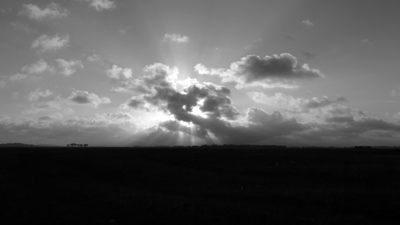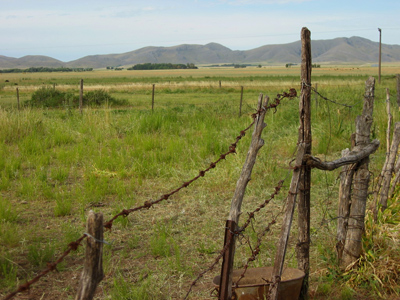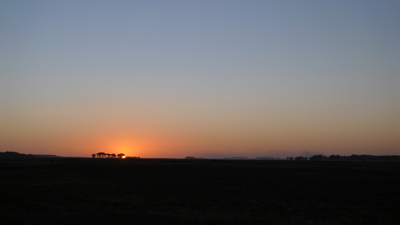
Although new to writing book reviews, “Radiografía de la Pampa” by Ezequiel Martínez Estrada left such an impact on me that I feel obliged to discuss it here. The book is filled with complicated ideas & is notoriously difficult to read, so maybe I can gain some insight by writing about it… as well as get ideas from others who read this post.
What a fantastic title. Taking an x-ray of flat, almost infinite nothingness seems pointless until the reader understands the goal of Martínez Estrada: probe into one of the most powerful of Argentine symbols. The pampa provided Argentina with an identity (the gaucho) as well as an economic means to prosperity (through cattle & crops). By x-raying the pampa, Martínez Estrada lifts the veil covering national identity… and it isn’t a pretty picture.
Written as a response to the military coup of 1930 & published in 1933, the overall tone of the book is pessimistic & tragic. The author exposes the flaws & mistaken assumptions of what it means to be Argentine. Harsh criticism to be sure, but some of the best lessons come from being a bit rough. Divided into six sections, Martínez Estrada describes in detail the origin of national problems.

I. Trapalanda – Spaniards who arrived became the new rulers of the land… a land of nothing. Reality unfortunately didn’t fit with their invented notions of the New World during the journey to America. They moved forward in space but backward in time & wanted what they couldn’t have… because it didn’t exist. The book starts with a bang.
II. Soledad – Proto-Argentines feel separated from their true homeland & fail to construct a united nation. An identity begins to form based on their environment: lack of security leads to mistrust which in turn leads to each man left to fend for himself… best seen in the guapo & the gaucho. Difficult section to read & maintain interest.
III. Las Fuerzas Primitivas – The first national laws were viewed as intrusive; they prevented what had previously been the normal way of doing business. As a result, they weren’t taken to heart. When I read the following section, Kirchner popped into my head immediately:
La carrera hacia el poder es la carrera hacia la impunidad, hacia la expansión de las fuerzas personales contenidas en el individuo por la sociedad… Pues sin esa arrogancia que sobrepasa en unos cuantos centímetros la estricta órbita de su acción, se traicionaría un ideal de multitud: hacer fortuna y mandar… el funcionario que hace lo que quiere, acaso con la conciencia de que cumple un deber, encarna un cierto poder encubierto y caprichoso que hay que atraer y conjurar. El cumplimiento liso y llano del deber haría despreciable la función; en cambio el fraude y el impudor son signos de fuerza, porque en ellos se ve al hombre más poderoso que la función y más temible.
In fact, one of the recurring remarks about this book in any review is that what Martínez Estrada said in 1933 is still just as valid today. Timeless.

IV. Buenos Aires – The capital is identified as a piece of Spain during the early days of independence & quickly grows to devour everything in sight. Martínez Estrada witnessed the vertical growth of the city & didn’t like it. He wasn’t fond of tango & called Carnaval “la fiesta de nuestra tristeza.” Had to laugh at that. He also felt that the southern section of the city is its truer character… something I’ve always said. Although generally portrayed in a negative manner, one part of Buenos Aires enchanted Martínez Estrada. He wrote the most beautiful description of Calle Florida I’ve ever read. What a place that must have been 80 years ago.
V. Miedo – Anyone who earns a fortune or does well in Argentina immediately begins to fear that it will be taken away… the price of instability. Likewise, an army without an enemy generates fear & instability. Brief section that seemed to be more of a commentary of current events in the 1930’s.
VI. Las Seudoestructuras – Knowledge of laws & justice are the best way to get around them both. I thought: that’s why there are so many lawyers in Argentina! Since a state of order does not exist in Argentina, people turn to the mystical. Martínez Estrada foresaw the growth of the conurbano & talks about Buenos Aires merging with La Plata one day.

“Radiografía de la Pampa” spares no one & makes no apologies. In spite of its negative tone, the book was received well after publication & has since been recognized as one of the most important works in 20th century Argentine literature. His writing can be poetic at times, dense at others, but Martínez Estrada shed some necessary light on Argentine character. At the end of the book, he criticizes those who improvise their way through life, always rushing around, never able to accumulate any degree of knowledge.
Vivir no es correr, ni pensar con prontitud; es desarrollarse en un espacio personalísimo, con una función personalísima, en un tiempo personalísimo; más bien demorarse un poco, “apurarse despacio” y marchar sin olvidarse de nada.
In other words, slow down every once in awhile to let it all sink in. Great advice even if you aren’t Argentine.
Update (15 May 2011): Just finished the short essay “La Cabeza de Goliat” also by Martínez Estrada, published in 1940. The second half rocks… full of commentary about day-to-day experiences on the streets of Buenos Aires (including the piropo!) & how our senses interpret the city. Great introduction to his writing style, & I was particularly struck by the following sentence:
…Buenos Aires todavía no ha sido descubierto, y aun para los que acostumbramos acariciarlo voluptuosamente con la vista, todos los días tiene sorpresas de emoción que venimos a estimar cuando estamos lejos de allí. La estética de la ciudad, ¿corresponderá al album más que al libro?